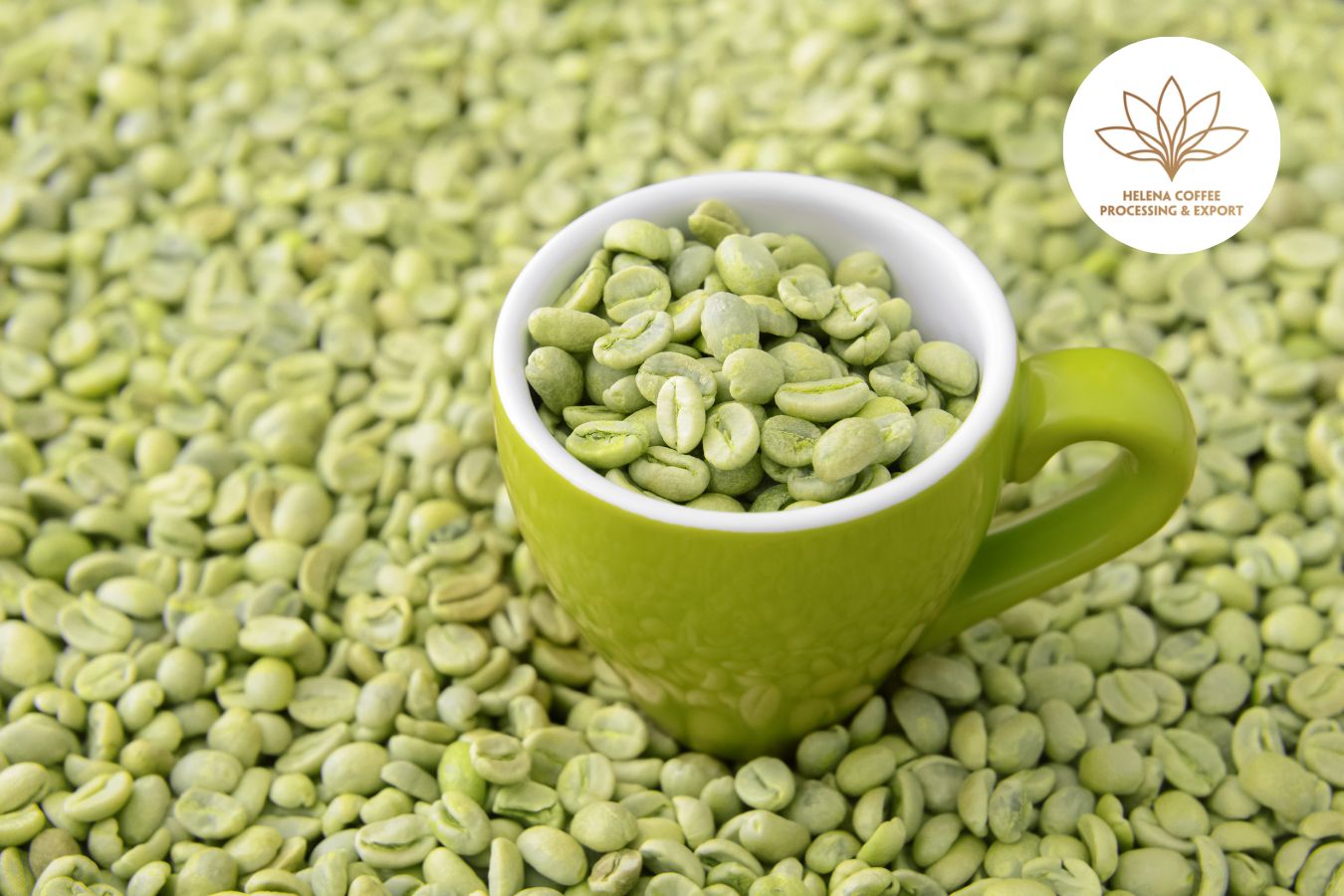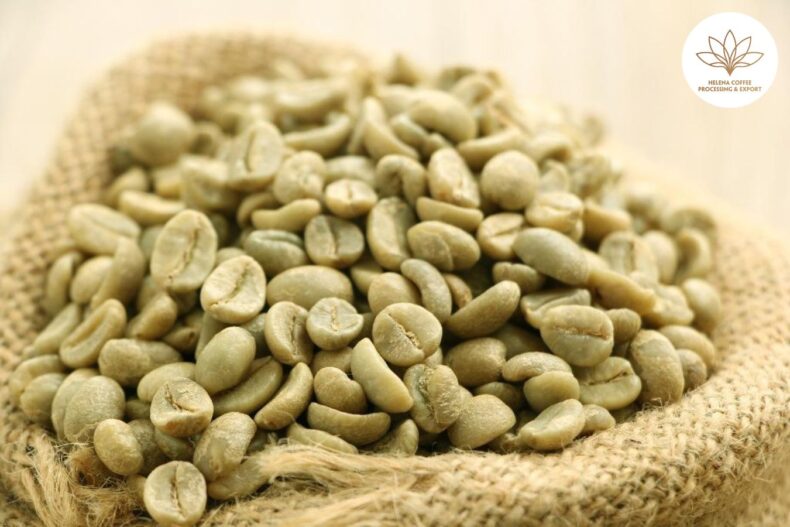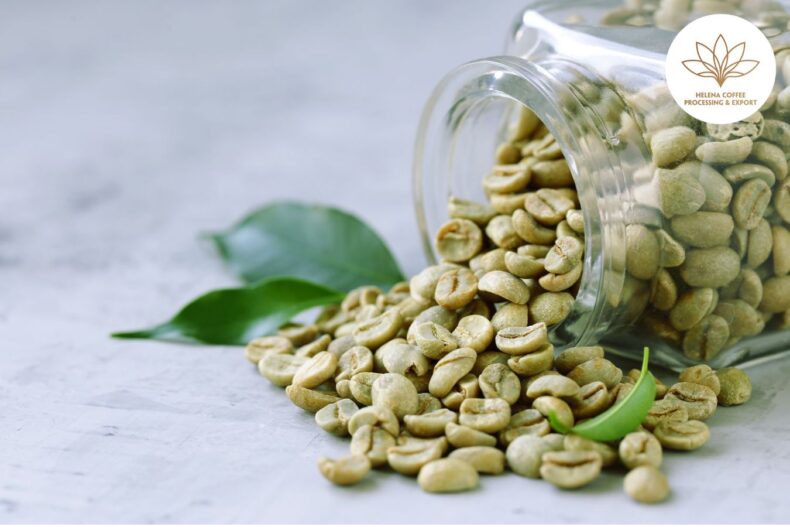
Defects In Green Coffee Beans : The SCA‘s green coffee bean grading standard accurately evaluates coffee beans.
It is superior to other methods because it compensates for the relationship between damaged coffee beans and flavor quality (for example, grain size categorization in East African countries, particularly Kenya).
You should, however, have a rudimentary understanding of some of the most common coffee flaws.

This article seeks to define the notion of faults described in fundamental coffee classification systems, including identifying the primary defect, its impact on flavor, and how to rectify it. In the process of being processed.
Specialty coffee classification guidelines
Classifies specialty coffee after roasting, visual inspection, and tasting (cupping). Visual examination entails taking a 300g sample of green coffee beans and noting all faulty beans and impurities (Full faults).
When there are no ‘main faults’ and fewer than five secondary defects,’ coffee is classified as a specialty.’ As a result, one variable that determines whether coffee is Society Coffee or not is the grading procedure.

We don’t usually notice these difficulties because they are only used in SCA certification’s green coffee grading examinations. If you work in the coffee industry, you’ll need more formal training (or to meet your company’s requirements).
As a result, I only cover a few methods for identifying various coffee flaws in this essay. If you need to go deeper, SCA’s Arabica Green Coffee Defect Handbook is an excellent place to start.
Differentiate between primary, secondary, and full defects
To begin, return to the SCA’s Coffee Beans Classification:
Primary Defects
| Defect name | Translation | Quantity * |
| Full Black | Full black | first |
| Full Sour | Sour | first |
| Pod / Cherry | Dried coffee berries | first |
| Large Stones | Big rock | 2 |
| Medium Stones | Small stone | 5 |
| Large Sticks | Big stick | 2 |
| Medium Sticks | Small stick | 5 |
Secondary Defects
| Defect name | Translation | Quantity * |
| Parchment | The seeds are still husked | 2-3 |
| Hole / Remember | Piece of rice husk | 2-3 |
| Broken / Chipped | Broken seeds | 5 |
| Insect Damage | Harmful insects | 2-5 |
| Partial Black | Partial Black | 2-3 |
| Partial Sour | Partly sour | 2-3 |
| Floater | Porous particles | 5 |
| Shell | Broken seed “elephant ear.” | 5 |
| Small Stones | Small stone | first |
| Small sticks | Small stick | first |
| Water Damage | Wet seeds | 2-5 |
(*) Quantity refers to the number of occurrences of each Primary/Secondary Defect that will be reported as a Full Defect.
- Impurities or badly damaged kernels are primary faults that hurt flavor quality and, more –
- importantly, they are immediately detectable.
- Secondary faults hurt taste but are less severe and challenging to detect.
- Complete defects, also known as total defects, are a combination of primary and secondary faults that determine the level of “defect” in the coffee.
There are seven common sorts of Defects In Green Coffee Beans.
Green coffee has numerous defects, some of which are more obvious than others; after all, we all know what a stick or ice cube looks like. However, understanding “whole black nucleus” or “totally sour nucleus” – these are seven sorts of primary (and secondary) faults to be aware of – will require some observation.
Understanding these flaws will make it easier for you to assess and analyze your coffee using the SCA Arabica Grading Form.
Black beans
Picking overripe coffee, over fermenting the coffee during processing, and finally keeping the coffee in a humid environment can lead to black beans.
An entirely black coffee bean is a primary flaw, while one that is speckled black (half a bean or less) is a minor fault. The following is an example:
- Primary spot: There is one fundamental flaw for every entirely black kernel.
- One fundamental flaw for every three coffee beans that are black 1/2 (or less).
If not removed, this fault form can create fermenting or foul aromas, dirt, mold, sour, and phenol taste in coffee. The most effective treatments are picking ripe berries from the tree and avoiding over-fermentation during processing.
Beans with a sour filling (brown)
Depending on the degree of fermentation of the beans, this is a typical flaw that causes a sour flavor or even a foul odor, which might manifest as a brown hue – hence the name. The brown kernel is its name.
In the same way as black seeds should be classified, sourdough faults should be classified as follows:
- Primary flaw: 1 whole defect for every browned kernel.
- Secondary deficiency: 1 complete defect for every three burnt coffee beans (or less).
When coffee beans are infected at various stages during harvesting and processing, this fault occurs. Picking overripe coffee cherries, picking up fallen berries, water contamination during processing, or even rotting, and fermenting while still on the tree owing to moisture can all contribute to this.
To eliminate sour beans from the source, we must collect ripe berries (avoid rotten ones), avoid picking up fallen and fallen fruits, and avoid planting coffee near rivers and lakes at low altitudes.
To avoid sour beans during the processing step, we must grind/grind the coffee pods as soon as possible after harvesting to avoid keeping them for an extended period. Simultaneously, it’s essential to keep an eye on the wet fermentation duration, prevent using polluted water and recycle water during the washing process (after fermentation). Ensure that the drying process is completed promptly to avoid any interruptions.
Cherry — Dried Peel, Dried Fruit, Dried Pod
“Dry pod” refers to the flat fruit that is dry due to the peeling process without removing the floating particles (porous, hollow seeds) from the receiving station’s initial water tank. Cherry-dried instant coffee is the product of hulled results in dry processing and is classed erroneously (due to lack of maintenance or adjustment of machinery and poor).
- The primary fault is dried coffee berries. One whole flaw for every such fruit
These screening flaws can result in a cup of coffee that is bitter and acidic (and are ideal conditions for mold growth, which spoils the batch). Furthermore, the dried pods can burn during roasting, causing damage to adjacent beans.
Insect damage — Insect-caused harm
The most important thing to note for the classification of defects caused by insects is how to convert to a total defect ( Full defect ) as follows:
- Primary Defect: Insects severely damage one out of every five cores, resulting in three holes (or more) per defect.
- Secondary Defect: Less than three chisels every ten cores, resulting in one complete defect.
Stem borers (Berries Borer bugs) enter the coffee cherries when they are young and dig inside to spawn, causing holes in the beans. The young typically emerge from the other side, resulting in a worm seed with two holes.
As the altitude rises, the incidence of Berry Borer disease decreases. Infested kernels will cause a sour, musty, or burnt taste if present in large quantities.

Floater/bleached – Floating (or white)
Improper storing or drying causes this mistake. Floater seeds frequently become stuck in the corners of the dryer or drying yard, resulting in pale, low-density, slightly porous grains (because they dry too quickly). Floater beans can form when dry-processed coffee is stored for an extended period.
Particles that float, are categorized as a Secondary Defect: 1 complete fault for every five floater particles
If not removed, the floating kernel might create a fermentable, weed-like, straw, earthy, moldy odor in the coffee cup. However, these flavors aren’t overpowering and can be readily neutralized if the number of spins is low.

Broken, Chipped — This kernel is cracked and chipped.
Some coffee beans will be fractured during the processing step, chipped by the high friction during the milling process (both wet and dry processing). To achieve this, the grinding machinery must be carefully adjusted to minimize excessive pressure. The finished product must then be passed through a sieve to be classified by density, minimizing minute particles.
Seeds that do not significantly impact flavor (but can generate an earthy, sour, or fermentable taste if used in large quantities) should be classed as secondary defects: 1 complete flaw for every five broken seeds.
Chipped seeds are generally dark crimson during wet processing due to oxidation at the cut location during the husking process. This can result in fermentation due to mold development and bacterial activity, resulting in unpleasant flavors. On the other hand, dry milled (after dry processing) flakes are generally clean and exhibit no traces of oxidation.

Shell – Elephant ear beads
The term “shell” refers to deformed beans that have a separate interior and exterior (or both) as a result of the coffee fruit’s original abnormalities ( Malformed metamorphosis ).
The shell kernel can be found in one or both sections in the batch of seeds, and in certain situations, they will stay together. The exterior section resembles an “elephant ear” but is fashioned like a shell; the inside might be conical or cylindrical.
- Shells are rated as a secondary fault, with one complete defect for every five shells.
Human shells have few drawbacks in taste, but their thin, delicate nature quickly burns when roasting, causing actual scorching and burning.
Additional forms of Defects In Green Coffee Beans
If you search the internet for coffee flaws, you’ll find very little — except some of the forms specified by SCA. This is perhaps self-evident, yet roasters rarely spend much time discussing their “mistakes.” However, if you dig a little further, you’ll be astonished at the many flaws in coffee production and processing.
I’ve added a few more types of flaws to the list above, which you should remove before roasting.
Young kernels of Quaker (unripe beans)
Quakers are immature coffee beans with reduced amino acid and sugar concentrations (underripe, unevenly ripened, or not well-formed due to nutrient deficiency).
As a result, a quaker grain lacks the chemical components required to engage in the roaster’s browning reaction (Maillard), resulting in a light hue. Quakers are known for their bitterness and astringency (drying of the mouth) and burnt popcorn flavor.
It is possible to limit Quaker kernels during harvesting by picking equally ripened coffee cherries and planting early to mid-ripening. Unripe or immature seeds can be floated out during wet processing to eliminate them (unripe seeds can be removed).
They are more difficult to detect in dry processing; therefore, coffee from Brazil has a high proportion of Quaker kernels — the country is primarily dry-processed by machines ( sweetmarias ).
Moldy human fungi harm
Mold-damaged kernels, often known as mold kernels, are one of the most common types of damage. However, they aren’t acknowledged by the SCA at all.
Mold damage — caused by fungi such as Aspergillus niger, Penicillium niger, and Fusarium niger, can infect coffee beans (as spores) at any stage during the harvesting and storage process.
The fungus will develop under the correct temperature and humidity conditions. The fungus damages the seeds, causing yellow to reddish-brown “powder” spots (spores) to form over time, eventually covering the entire coffee bean and infecting neighboring beans.

Fix mold on coffee
Many phases in coffee processing should be scrutinized to avoid mold. To begin, efforts should be made to reduce the spread of fungal spores. This includes not picking up coffee cherries that have fallen to the ground or accumulated in harvest sacks and drying tanks.
Seeds cut or chipped during wet hulling, uncontrolled fermentation, seeds left in the fermenter, delays or interruptions in the drying process, seeds re-wetted owing to storage in wet conditions, and so on should all be considered throughout processing.
Beans that have withered – Beans that have withered
Wilted coffee cherries produced wrinkled kernels with a grassy, straw-like flavor when brewed due to a lack of water (drought) during the development of the plant. The severity and duration of the drought determine the degree of the damage.
Wilted coffee cherries can be removed by soaking during wet processing; wilted cherries are usually spongier, lighter, and float to the surface. Because of their tiny size and low weight, withering fruits can be eliminated by density in dry processing.
There are several Defects In Green Coffee Beans that everyone is aware of
The flaws listed above are rather complicated, and filtering the categorization requires some skill. Most roasters, on the other hand, sort their beans extremely carefully before roasting, and there are some by-products from the operation that must be removed shortly before roasting:
The pods can appear in coffee that has not been adequately screened, whether wet treated or naturally processed. Due to improper peeler calibration, the pods and the green coffee will dry out. They have an earthy, musty, fermentable, or phenolic flavor when consumed in large numbers.
Green coffee beans with extraneous contaminants, such as twigs, stones, or nails, have a terrible form and indicate inadequate processing and grading. If not removed, these contaminants can harm equipment, particularly blenders.
If you’re fortunate enough to work with dependable vendors, come here (farmers). The number of flaws in the coffee can be kept to a minimum. However, it’s vital to remember that each farm and location will yield unique coffee beans. The coffee stem borer may be a problem in some areas, during drought or unexpected rain in others.



FAQ:
- Non-defective coffee beans
- Roasted coffee beans
- Sour coffee beans
- Beans coffee bean
- Healthy coffee beans
- Coffee green beans
- Beans non-defective coffee
- Black coffee beans
- coffee bean defects


